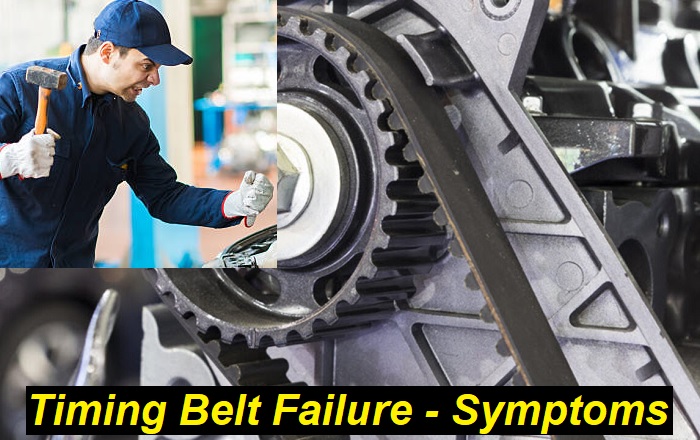The timing system in most engines is driven by a belt. This belt is extremely reliable and durable, but once every 40-60 thousand miles (depending on your vehicle) you will still need to have it replaced. The procedure of replacing a timing belt is not as simple as it may seem to be. You need to be an experienced mechanic to complete this task.
Engine repair mistakes highlights
- Level of importance:extremely important
- When done:DIY repairs or diagnostics
- Cost of mistake:$250 - $4,000
- How to avoid:professional inspections, getting help from mechanics
- Consequences:broken engine, need for engine replacement
- DIY solutions:not many

How can you install the timing belt incorrectly?
It's not hard to make a mistake when installing the timing belt. The problem is that the timing system in most modern cars is extremely complicated and it needs proper approaches when repairing or servicing. First of all, the person who replaces the timing belt should know the manufacturer's instructions.
Even if you just overtighten the bolts in this system, the problems will come. Also, the instruction says where you should look at labels or marks to understand that the crankshaft and camshafts are in the correct position.
So, here's how the timing belt is installed:
- the old belt is taken off the system;
- the new tensioner is installed;
- new pullies are installed in the needed places;
- very often, the new water pump is installed to prevent problems with it;
- after that, the new belt is installed;
- the special marks are controlled on camshafts and crankshaft;
- the bolts are tightened;
- the covers are installed to protect the belt.
Of course, this may not be that simple because many modern engines have different construction of the timing system and will make you spend a whole day to just get the chance to take off the old belt.
You should be ready for problems to gather all the marks in needed points. It's not that easy to do even if you have some experience in this. But once you miss even one mark, the engine will not work correctly. In the case of the timing belt, everything must be very precise and correct. Missing a small thing will result in the need to redo all the work.
What happens with your engine when the belt is installed badly?
We'll try to say it with simple words so that all our readers can understand what's happening in such situations. The timing belt is the belt that drives simultaneously the crankshaft and the camshafts. So, at a certain moment when the crankshaft sends one piston to the top of the cylinder block, the camshafts open the intake valves in the needed combustion chamber.
The process can be described like this:
- the crankshaft turns to the position where the pistons in the first and the fourth cylinders are at their top position;
- the crankshaft which is driven by the same belt opens the intake valves located above the first and the fourth cylinders;
- the fuel-air mixture is injected into the combustion chambers and is ignited by the spark plugs;
- the combustion takes place and pushes the pistons down;
- the same happens with two other pistons - while the first and the fourth ones go down, the second and the third ones go up;
- when the pistons go down, the camshafts open the exhaust valves to let the engine get rid of combustion gasses;
- the process repeats hundreds of times every minute.
This is actually the way the internal combustion engine works. But if the timing belt goes just one tooth forward or backward, the symphony is lost immediately. It means that the intake valves will not open at the needed moment and will not let in a needed amount of fuel.
Also, the exhaust valves won't open at the needed time and the engine will not get rid of the combustion gasses. This will lead to huge problems starting with the loss of compression and finishing with the complete loss of power. But the consequences may be even more severe for your engine and for your budget.
What are the symptoms of the wrong timing belt installation?
- Stalling. Your engine may start if the mistake is not that critical, but it will stall after some time and won't start again.
- Shaking. The engine will obviously shake because it will balance between stalling and keeping working.
- Complete loss of power. Even if the engine will be working, it will not deliver a lot of power to the wheels.
- A lot of smoke. The quality of the fuel-air mixture will not be optimal, so the smoke from the exhaust pipe is guaranteed.
- Dancing revs. The tachometer gauge may start dancing when the engine is idling because the ECU tries to prevent stalling.
- One or two cylinders not working. Some cylinders may not be working at all because they don't get optimal fuel-air-mixture.
- The engine is stuck. This is the worst situation. If the belt was installed without any marks, once you try to start it, it will be stuck because the valves will hit the pistons.
What to do if you suspect that the timing belt is wrongly installed?
The obvious thing you should do is to stop using your vehicle. Well, you can't use it because it doesn't want to go anywhere. But sometimes the one-tooth mistake will still allow you to drive. Don't do that because the consequences may be very bad.
Here's what you should do if you think that the timing belt wasn't installed correctly:
- stop your engine immediately and don't try to start it again until you find the actual problem;
- call the tow truck and get your vehicle to the repair shop where your timing belt was installed;
- ask the mechanics to take the covers off and look at the timing belt marks;
- if the marks are OK, ask them to find any other reason for strange engine problems;
- if the marks are not OK, ask them to reinstall the timing belt;
- before reinstalling, make sure that the belt is OK, and it's not damaged.
By the way, the same symptoms and recommendations match the timing chain problems. But the timing chain jumps can be even worse in terms of the consequences your engine may face. So, don't experiment with the engine if it acts as if the timing belt or chain is installed incorrectly. Or you can just buy a new engine after your experiments.
What are the consequences of a wrong timing belt installation?
The consequences will be different according to the construction of the engine. One unit will be absolutely OK - you will just need to reinstall the belt and keep driving the engine for years with no problems. Usually, it's true for old classic engines.
But for some other units, the problems may be much more complicated. For example, your engine can lose a couple of valves or it may get stuck because of a huge hit of valves over pistons. The possible problems are hard to predict and they depend on a couple of factors.
Here's what will define the scale of your problems:
- the difference between optimal belt installation and the position that you have in your engine;
- the type of engine - some are OK with totally incorrect belt installations while some are not;
- the number of times you tried to start your engine with a wrongly installed timing belt;
- the type of pistons you have - some manufacturers make special pistons that can't hit over the valves;
- your luck.
Every time something bad happens with your timing belt, it's all about your luck. Sometimes, the modern and highly technological engines are absolutely OK after such problems. But sometimes even those classical engines which are hard to kill get big problems after the timing belt is installed incorrectly.
Final words
We suppose it's a very bad idea to let some unknown mechanic dig in your engine and install the timing belt. This may lead to huge problems and big expenses. The wrongly installed timing belt can immediately kill your engine and make it economically incorrect to repair. Even new engines can be easily killed if they have this problem with timing belt installation.
If you need to replace the timing belt in your engine, better find a specialist who can do that without any mistakes. We don't recommend replacing timing belts by yourself. You may just not know one of the important stages of this procedure. Also, make sure you buy original or highly recommended parts for timing system maintenance in your vehicle.
About the authors
The CarAraC research team is composed of seasoned auto mechanics and automotive industry professionals, including individuals with advanced degrees and certifications in their field. Our team members boast prestigious credentials, reflecting their extensive knowledge and skills. These qualifications include: IMI: Institute of the Motor Industry, ASE-Certified Master Automobile Technicians; Coventry University, Graduate of MA in Automotive Journalism; Politecnico di Torino, Italy, MS Automotive Engineering; Ss. Cyril and Methodius University in Skopje, Mechanical University in Skopje; TOC Automotive College; DHA Suffa University, Department of Mechanical Engineering






Add comment